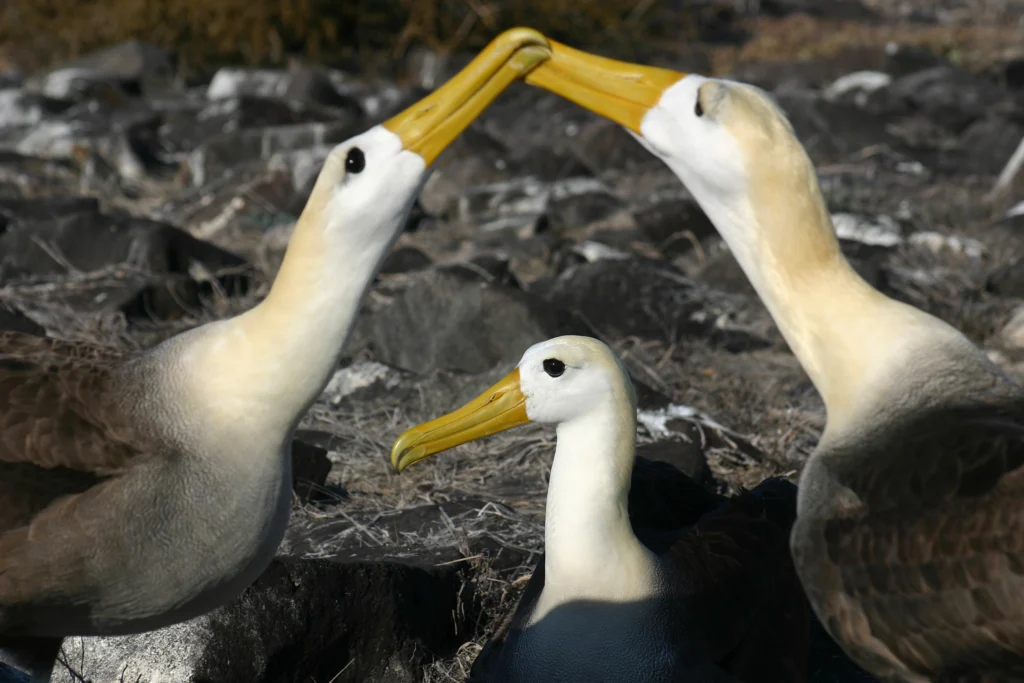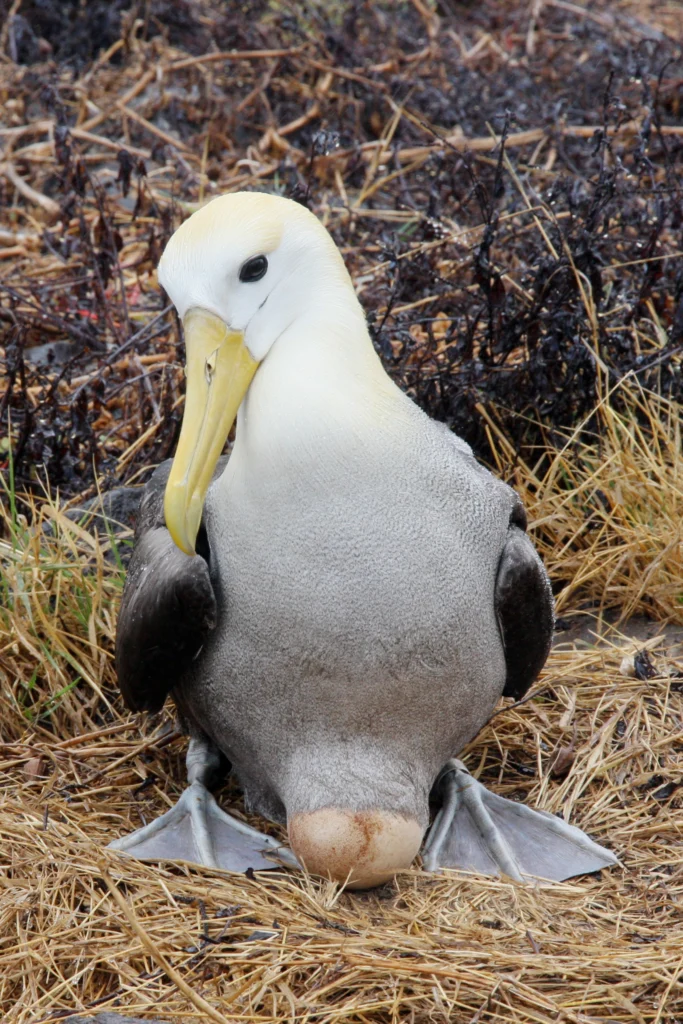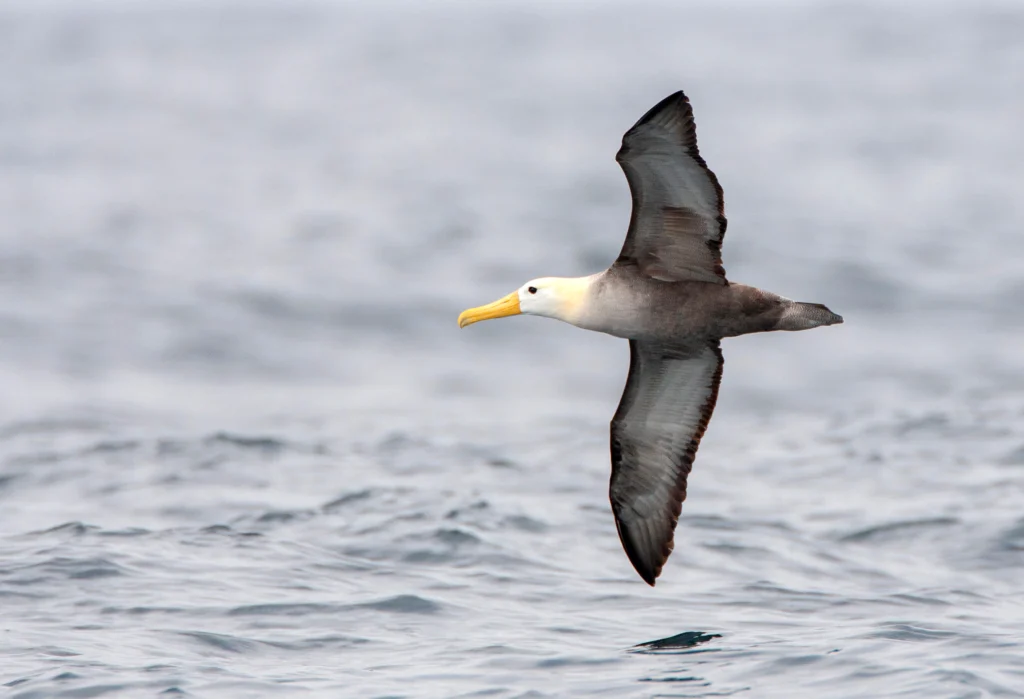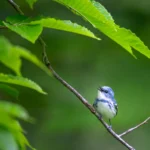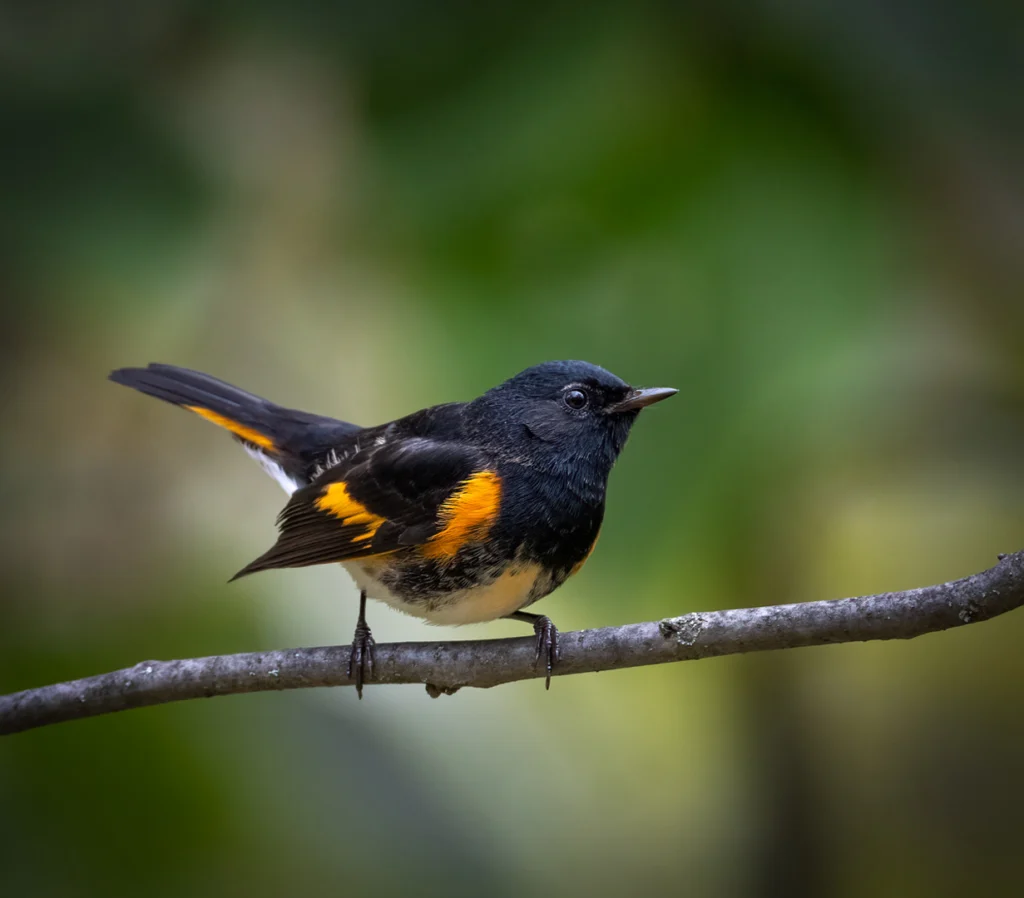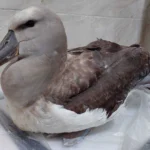
Overview
About
While the Waved Albatross spends plenty of time riding air currents over the waves, its name actually derives from the wave-like pattern on this bird’s brown body plumage. Like all members of the albatross family, including the Laysan and Black-footed Albatrosses, this superlative glider spends most of its life over the open ocean. It is the only albatross species restricted to the tropics.
Also known as the Galápagos Albatross, the Waved Albatross has a 7- to 8-foot wingspan. Although it’s the largest bird in the Galápagos, this species is just medium-sized for an albatross; the largest, the Wandering Albatross, has a wingspan of up to 12 feet!
Threats
Seabirds are among the most rapidly declining bird groups in the world. Long-lived birds like the Waved Albatross all too often have their lives cut short by threats from fisheries and plastics, and a changing climate jeopardizes their food resources.
Fisheries
Longline and inshore fisheries attract Waved Albatrosses to hooked bait intended for fish. Each year, thousands of seabirds are accidentally caught on the hooks and drown.
Climate Change
Longline and inshore fisheries attract Waved Albatrosses to hooked bait intended for fish. Each year, thousands of seabirds are accidentally caught on the hooks and drown.
Plastics & Pollution
Scarce food sources make it even more likely that Waved Albatrosses may consume plastic floating on the ocean’s surface, with disastrous results.
Conservation Strategies & Projects
Birds need our help to overcome the threats they face. ABC’s Marine Program works with partners to reduce threats to the Waved Albatross and other seabirds through a combination of direct conservation actions, outreach, and policy work.
Addressing Fisheries
Since 2008, ABC has worked in the artisanal longline fisheries of southwestern Ecuador to understand how Waved Albatrosses and other species interact with fishing gear — and how fishing practices can be modified to reduce accidental bycatch.
Support Petitions and Advocacy
ABC continues to urge the United States to support legislation to ratify the Agreement on the Conservation of Albatrosses and Petrels (ACAP) and advocate for measures that protect albatrosses and other seabirds. Learn about current actions you can take to support bird-friendly policy.
Bird Gallery
An adult Waved Albatross is brown above with a white head and neck tinged in yellow and a mustard-colored bill. White underparts are finely patterned with wavy brown lines from the upper breast to the undertail, giving the bird its name. The feet and legs are bluish, and the eyes are dark brown. Young birds are all brown, gradually developing the white head as they age. Males are larger and heavier than females.

Bird Sounds
The Waved Albatross is silent at sea, but performs noisy displays on its breeding grounds, with loud, honking and croaking calls accompanied by visual displays like pointing their bills skyward, bowing, and bill clacking. Listen to the sounds of a Waved Albatross colony below!
Scott Olmstead, XC24276. Accessible at www.xeno-canto.org/24276.
Habitat
The Waved Albatross forages on the open ocean, sometimes nearing the shore as it follows the cold-water Humboldt Current. It nests on bare lava fields amid scattered boulders and sparse vegetation.
- Spends most of its life on open ocean
- Uses lava fields for nesting

Range & Region

Specific Area
Islands off the coast of Ecuador
Range Detail
Birders who wish to add Waved Albatross to their life lists must travel south of the equator to Ecuador, the only place on Earth where this species breeds. Most Waved Albatrosses breed on Española Island in the Galápagos archipelago, but a smaller breeding colony can also be found on Isla de la Plata, 17 miles off the Ecuadorian coast.
Adult Waved Albatrosses spend the nonbreeding season at sea off the west coasts of Ecuador and Peru, where they may congregate in large groups.
Did you know?
The Waved Albatross is the only albatross species that lives its entire life within tropical latitudes.
Life History
Like other large birds such as the Trumpeter Swan and Whooping Crane, Waved Albatross pairs mate for life. While they may spend the nonbreeding season apart, the birds meet again, year after year, on their familiar breeding grounds. The breeding season starts when the albatrosses return to land in March.

Diet
Waved Albatrosses often feed at night when squid, their favored food, swim closer to the ocean’s surface. The birds also eat fish, sometimes scavenging near fishing boats, and a variety of marine invertebrates.
Like the Great Frigatebird, the Waved Albatross practices kleptoparasitism, stealing food from other birds such as Blue-footed Boobies. It’s the only albatross known to regularly use this technique.
Courtship
Waved Albatrosses perform a fascinating mating ritual that helps to strengthen their pair bond: Male and female face each other, large yellow bills touching, then stroke and tap their bills together, making a hollow sound. This “bill-circling” behavior is interspersed with bowing, bill-clattering, and sky-pointing, accompanied by a cacophony of hooting, honking, and whistling sounds.
Nesting
After mating, the female Waved Albatross chooses a nest site on bare, rocky ground, preferring areas where vegetation is trimmed short by grazing giant tortoises.
On Española Island, where the native tortoises were almost wiped out by humans, vegetation grows more thickly and sometimes entangles Waved Albatross chicks. Ongoing conservation efforts are slowly returning the island to a healthier state, and more than 1,500 giant tortoises roam the island now.
Eggs & Young
The female albatross lays a single egg, and the pair share incubation duties over a two-month wait, then take turns foraging at sea to feed their chick. But at several weeks old, the young bird is mature enough to be left unguarded. Groups of chicks wait while parents fly to sea together and eventually return with stomachs full of food: a pre-digested, nutrient-rich, oily liquid perfect for young albatrosses. This liquid can remain in the parent’s stomach for a long time, enabling the adults to forage less frequently.
Chicks start attempting to fly about five and a half months after hatching. In one of the most incredible aspects of albatrosses’ lives, the fully fledged young birds will spend up to six years at sea before returning to land to find a partner. They will then return to breed each year of their long lives of up to 45 years.

